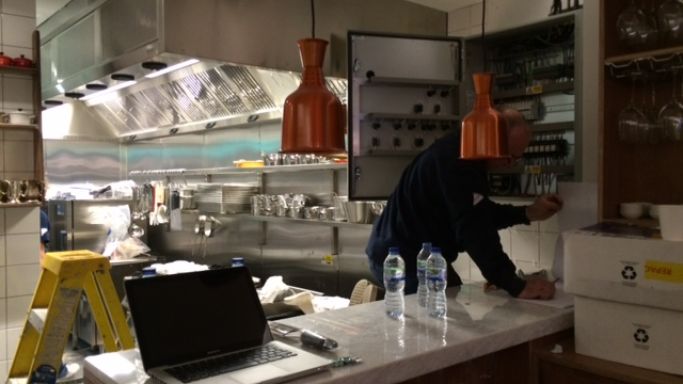This article is also published in the Financial Times.
That 2014 ended on a very high note for many London restaurateurs was confirmed by figures from very two different sources.
The first came from Peter Harden, who with his brother Richard edits the Harden’s Guide, and keeps the score on such matters.
According to his figures, there were 148 new restaurant-openings in London last year and only 47 closures, not just a record number of openings but also the highest ratio between openings and closures since 1996.
An even longer perspective on this phenomenon was cast by Roger Oliver, the genial managing director of the London Linen Group, the principal supplier to the capital’s restaurants of pristine tablecloths, napkins and chefs’ uniforms. He reported that the week leading up to Saturday 20 December 2014 had been the busiest in his company’s 79-year history.
But from another source, kitchen designer James Lee, whose company can be involved in restaurant openings even before the lease is signed, I hear that these record numbers may easily be surpassed in 2015.
Over a double macchiato, he responded to my question, ‘How’s business?’ by smiling broadly and proudly responding, ‘Nick, I don’t think we’ve ever been busier. We’re currently working on 31 kitchen designs across London.’ These range from a complete revamp of the kitchens at The Ivy, a brand new restaurant close by in Cambridge Circus, to several more branches of the seemingly already ubiquitous Bill’s.
Communications between the customer and the restaurant are also likely to change during the coming year in a spectrum of areas I can best describe as varying from impersonal to sweet.
The new restaurant apps are likely to have a major effect on the once very personal relationship between the restaurant and the customer. Following the success of Uber, significant amounts of venture capital are now flooding into start-ups principally in California that aim to bring about similar changes to how, and especially where, people eat out.
Here are just a few. Resy, www.resy.com, which partners with restaurants to hold back tables to be sold via their app; Reserve, similar in outline but this also, like Uber, allows the customer to rate the restaurant and vice versa as well as incorporating an inbuilt payment system; I Know The Chef, www.iknowthechef.com, which focuses at the moment on restaurants in Chicago, Miami and New York; Zurvu, www.zurvu.com (strapline You’re So In), which after its first year has just signed up its 75th restaurant in New York and Philadelphia; and Table8, www.jointable8.com, which also doubles as a singles dining club. Late spring will also see the much-anticipated launch of Tock, www.tocktix.com from Chicago’s Nick Kokonas.
The founders invariably justify their new sites by claiming that by removing the reservation process they allow the restaurant to concentrate on what it should do best, notably cooking and serving their food. But what concerns many is that these systems also remove the initial direct contact between the host and guest and will consequently make it more difficult to manage expectations. This is particularly true when even the guest is not entirely au fait with the name their booking has been made in.
At a time when the issue of no-shows, parties not just not turning up but not even bothering to cancel, is increasingly acute, restaurant receptionists are coping with an increasing number of 'concierge sites'. These make reservations at the most sought-after restaurants as soon as their booking lines open and then sell them on. When I asked the general manager of a leading New York restaurant to describe the impact of these new businesses, his response was a terse ‘havoc’.
But at least he and his counterparts have not had to come to terms with the new EU legislation that came into force on 14 December that makes it mandatory for menus and wine lists to reveal 14 major food allergens.
While the solution for the sommelier is relatively straightforward, as at least some of this information (the near-ubiquitous presence of sulphites, for instance) is printed on the label, the challenges for chefs and waiting staff will be immense. On a purely aesthetic note, this could mean that the days of the elegant, sparely-written menu are over.
Compensation could lie in the appearance on the dessert section of an entirely new category on the menu: chocolate boards.
These are the creation of Spencer Hyman who left his career in private equity to follow his taste for chocolate and established Cocoa Runners, www.cocoarunners.com, that currently supplies its members with a delivery of different chocolate each month.
A chocolate board looks like a charcuterie board, and if Hyman has his way will be presented as an alternative to a dessert. On it will be squares or rounds of different chocolate that Hyman would supply, changing the source each month. Coffee, tea and several pieces of chocolate to share from Madagascar, Ecuador, Bolivia or Australia – the source, Hyman believes of the next wave of excellent chocolatiers – would make a sweet finale.
This could be a real breakthrough on menus from 2015 onwards as everyone benefits. It would be good for restaurateurs who, outside tasting menus, currently persuade only 25% of their customers to order dessert; it may well appeal to customers, of whom many have a sweet tooth but often pass on dessert for fear of looking greedy; and his approach of canvassing sommeliers to enthuse about chocolate boards is clever as the flavour descriptors of chocolate and wine overlap.
Chef Anthony Demetre and restaurateur Will Smith will be the first to offer chocolate boards to their customers at their Wild Honey restaurant in Mayfair (pictured) from Monday 5 January. Many more, I believe, will follow.
Wild Honey 12 St George Street, London W1S 2FB tel +44 020 7758 9160

